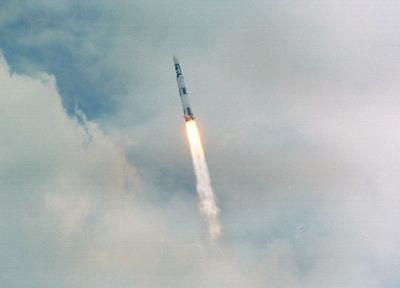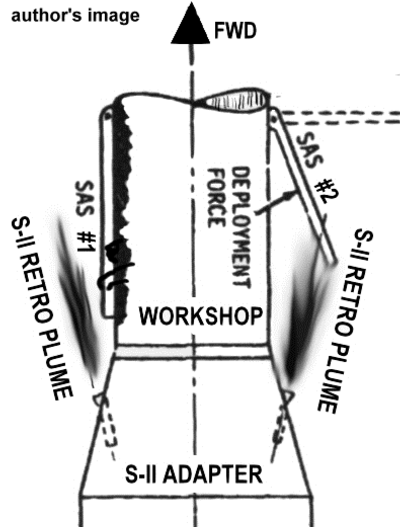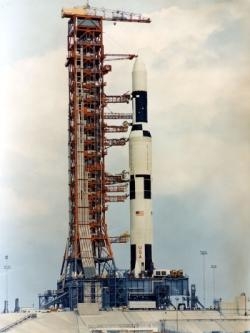They Almost Lost The Whole Vehicle
By Wes Oleszewski
Springtime comes and the trees become green, flowers bloom, birds sing, bees buzz and a young boy’s thoughts turn toward… Skylab. Well at least mine always do. At the time of Skylab I was a High School kid and rabid space-buff who had just witnessed the end of Apollo. Thus, the concept of having US astronauts up in space for weeks and even months at a time aboard the Skylab “workshop” was pretty cool. Besides, on my first visit to the Kennedy Space Center three months earlier, I had seen Skylab 1 through an open door in the VAB. Okay, so what if it was just a sliver of a peek at the base of the LUT, but still- I saw it! So, as the launch day for Skylab 1 approached- I was glued to the TV.

The launch of the Skylab Saturn V, AS-513, took place 40 years ago today, on May 14, 1973 and is best remembered for some events that began about 63 seconds after liftoff. This series of “anomalies” can be found described in historical shorthand by both NASA publications and media presentations as being the moment when the workshop’s micro-meteoroid shield prematurely deployed and was caught by the slipstream and torn off of the Skylab. It is also one of the most mis-described major events in manned spaceflight history; even NASA’s own released documentaries get the events wrong. I can say that because I am one of the few writing about the events of the Skylab 1 launch who has actually taken the time and studied and dissected the original published NASA and MSFC reports on the anomalies.
Overall the results of the series of anomalies that took place during the boost of Skylab 1 were the workshop overheating and a jammed solar panel wing. The second solar panel wing had been lost off of the workshop completely, but it was not until after the workshop was in orbit and data was carefully analyzed that it would be discovered just how that happened. The first crew to go up to the workshop performed repairs and the next two missions were conducted as planned. Although most accounts of the launch, and the Skylab program normally leave it at that, my study of the overlooked details of “the 63 second anomaly” are far more interesting and far more frightening. AS-513 came within seconds of becoming the first Saturn V to be lost in flight.
Here is how it happened.

At 62.807 seconds after liftoff the launch telemetry showed that the vehicle began to react to an external, abnormal aerodynamic force. This was 1.707 seconds after Mach 1 (the sound barrier) had been passed and was the beginning of the anomaly that was the premature deployment and subsequent loss of the workshop’s micro meteoroid shield. Too often poorly researched accounts say that the event took place at Max-Q, or the point where the vehicle experiences maximum aerodynamic pressure, but Max-Q was a full 10.63 seconds into the future and the meteoroid shield was long gone by then.
What really happened was that as the Mach 1 shock wave passed down the vehicle a reverse flow of air along the skin of the vehicle found its way up what was called the “Auxiliary Tunnel”; a conduit that ran the length of the workshop. Entering through two uncapped stringers at the base of the tunnel, the high pressure air moved up the tunnel and popped the rubber boot at the top. The airflow then got up under the shield structure and propagated a bulge that was just enough to lift the shield more than two inches into the slipstream, which was now at Mach 1.05. By 63.289 seconds into the flight, less than one second after it had started, the damage was done and the shield had torn away and loosened both Solar Array Assembly (“SAS”) wings as it went. The worst of the damage, however, was not done yet.
As the two and a half story tall 22 foot wide hunk of meteoroid shield fell. It struck the Saturn V at least twice. The first impact was on the S-II adapter, where the debris punched a hole in the adapter’s skin. This showed up in post flight data as the pressure in the adapter area was shown to drop at an abnormal rate. However, the potential fatal blow came when the shield’s remains struck the Saturn V for the second time. The impact area included the second plane separation point where the shaped charge was located that pyrotechnically blows the parts of the airframe apart so that the “skirt” ring can be dropped. This “skirt sep.” often seen in videos, normally takes place 30 seconds after first stage separation. It is a critical event and, in manned Apollo flights, if the skirt failed to separate from the S-II, it was an abort situation requiring use of the escape tower. The reason why this “skirt sep.” is so critical is not one of weight, but rather
it is thermal in nature.

If the skirt failed to drop away, hot gasses from the five J-2 engines would become trapped in the confines of the skirt and the issue would become critical at center engine cut off. Then, with the four outboard engines still firing in the near vacuum of space and no center engine to provide its flow, a back-flow of heat would occur. The temperatures imposed on the base of the stage along the thrust structure would quickly spike and go into the range where a “thermally induced failure” of the stage could take place as the thrust structure melts and the burning engines push up into the LOX tank. On AS-513, that is what began to take place and the vehicle was within seconds of failure when the shutdown of the four outboard engines finally occurred. Had there been the loss of one engine, and the stage had been forced to burn a bit longer to compensate, they’d have lost the entire vehicle.
So, why didn’t the skirt separate? Here is why. Normally when the separation signal was given, two Exploding Bridge Wire units fired at opposite ends of the Linear Shaped Charge (LSC) loop that passed completely around the vehicle at the separation plane. The detonating LSC would blow apart 199 tension straps holding the two sections together and the two sections would come apart. A back-up charge would fire if an electrical plug between the two sections did not disconnect, indicating that the two sections were less than ¼ inch apart. On AS-513, the meteoroid shield impacted the seam where the LSC for the skirt was located and broke the loop. When the LSC fired, the explosion only propagated 165 degrees around the separation plane- (about 89 tension straps), but that was enough to pull the electrical plug used to indicate separation out more than ¼ inch; so no back-up charge firing was commanded and ground controllers had a green light on the “skirt sep”. Thus, the
vehicle continued on its way and no one knew that the skirt was still attached because ground cameras were blocked by cloud cover. It was not until post-flight data was examined that the spike in S-II base heating was discovered. Later it was also calculated that that the huge meteoroid shield had impacted the S-II skirt at between 200 and 1,000 feet per second. It was a close one-they almost lost the entire vehicle!
A second anomaly, which is also always misreported, involved the loss of SAS wing #2. While most accounts say that it was lost with the meteoroid shield … in fact IT WAS NOT. Although loosened by the shield’s departure, SAS wings #1 and #2 stayed connected to the work shop all the way up. At S-II shutdown, however, four solid fuel retro rockets mounted at 90 degree intervals around S-II forward adapter skirt fired to aid in separation of the S-II from the upper stage. SAS wing #2 was centered just 16.8 degrees off of one of the retro rockets. The plume from that retro firing hit the already loose SAS wing and blew it “…completely off the bird.” as Pete Conrad observed later. SAS wing #1, however, was held down by debris from the meteoroid shield which was enough to hold it against its associated S-II retro’s plume.

You do not have to take my word for all of this folks. All of the information seen here is contained in NASA/MSFC document MPR-SAT-FE-73-4 “Saturn V Launch Vehicle Flight Evaluation Report; SA-513 Skylab 1” published on August 1, 1973. If you are asking why everyone, including NASA itself gets it wrong all the time, it is because documentaries are normally written and almost always produced by people who have little knowledge of the actual history of spaceflight and also have no inclination what-so-ever to go and research the facts from original, technical source material. NASA’s own documentaries suffer from the same illness because they are often produced outside of NASA, plus they are always researched and produced by the lowest bidder.
Although Skylab was largely ignored by the media of the day and is somewhat forgotten today, its booster, AS-513, was unique- not only in its appearance- but also for its 592 second wild ride up hill. In 1973 we space buffs weren’t told a lot of details about this Saturn V’s flight- the media didn’t care and NASA wasn’t looking to expose their own faults any more than they absolutely had to. But now you not only know the facts about AS-513, but you can also have the satisfaction of watching, or reading all of the 40th anniversary accounts of the launch of Skylab 1 and when you hear them say, or read them state that the damage took place at “Max-Q” or “…at the point of maximum vibration…” (which is one of my personal favorite moronic statements made in such presentations), you can snicker and say; “They got it wrong again.”
(Note: This text is a segment from a series of books being written by Wes Oleszewski titled “Growing up with Spaceflight” that will be released on Kindle beginning in 2014.)
(Drawings by Wes Oleszewski. Photos courtesy NASA)
 ANN's Daily Aero-Term (04.14.24): Maximum Authorized Altitude
ANN's Daily Aero-Term (04.14.24): Maximum Authorized Altitude ANN's Daily Aero-Linx (04.14.24)
ANN's Daily Aero-Linx (04.14.24) Classic Aero-TV: 'We're Surviving'-- Kyle Franklin Describes Airshow Life 2013
Classic Aero-TV: 'We're Surviving'-- Kyle Franklin Describes Airshow Life 2013 Aero-News: Quote of the Day (04.14.24)
Aero-News: Quote of the Day (04.14.24) Airborne 04.09.24: SnF24!, Piper-DeltaHawk!, Fisher Update, Junkers
Airborne 04.09.24: SnF24!, Piper-DeltaHawk!, Fisher Update, Junkers






